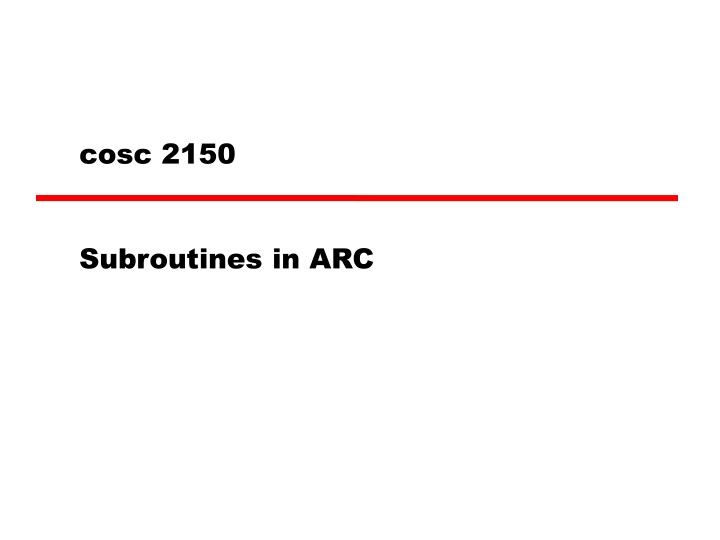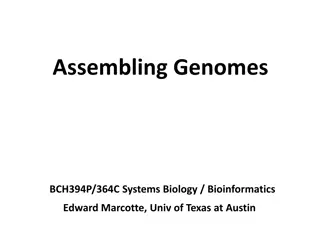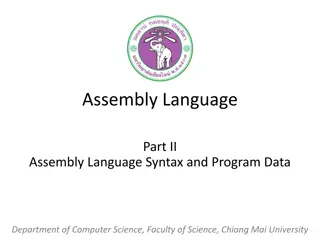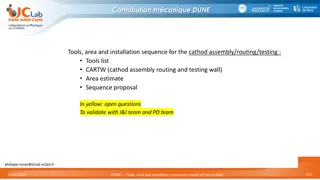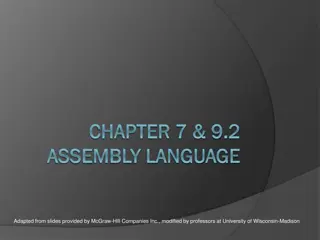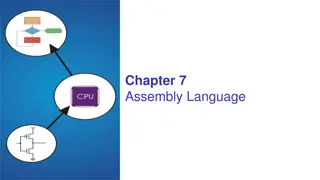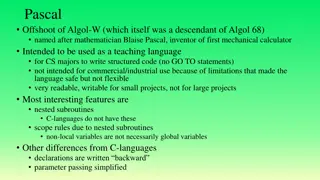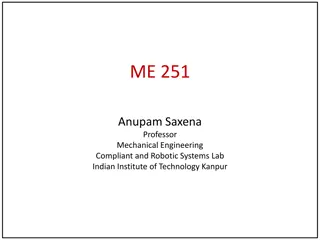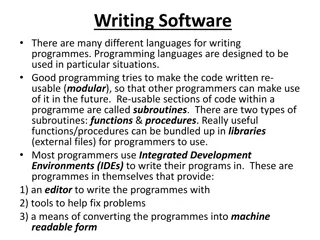Subroutines in Assembly Code
In Assembly code, subroutines play a critical role in structuring code execution. They allow you to segment code for reusability and organization. Subroutines are invoked using specific instructions like call and jmpl, enabling the program to jump to designated addresses and manage return addresses effectively. Additionally, utilizing a stack is essential for storing return addresses and managing subroutine execution flow.
Uploaded on Feb 18, 2025 | 3 Views
Download Presentation

Please find below an Image/Link to download the presentation.
The content on the website is provided AS IS for your information and personal use only. It may not be sold, licensed, or shared on other websites without obtaining consent from the author.If you encounter any issues during the download, it is possible that the publisher has removed the file from their server.
You are allowed to download the files provided on this website for personal or commercial use, subject to the condition that they are used lawfully. All files are the property of their respective owners.
The content on the website is provided AS IS for your information and personal use only. It may not be sold, licensed, or shared on other websites without obtaining consent from the author.
E N D
Presentation Transcript
cosc 2150 Subroutines in ARC
Assembly code There are two instructions used for subroutine calls call label This will change the PC to where the label s address and put the current address into %r15 jmpl %rX+4, %rY will jump to the address %rX and put the current address in %rY Normally %rX is %r15, the +4 is because you would return the call instruction, instead of the next instruction.
example . (instructions) call sub_r ! call subroutine sub_r sub %r2, 2,%r1 . (more instructions) halt sub_r: addcc %r1, 2, %r2 jmpl %r15+4, %r0 !go back to sub instruction
Code style Subroutines are written so that you execute a piece of code and then return back. You can not branch out of a subroutine back to the "main" code. Your subroutines are not be "inside" the main code either. IE, you can not branch over a subroutine. Call places the return address in %r15. We MUST store this value into the stack so we have the value later. Because if the code makes another call, the register will be over written.
The stack The stack is not fully implemented in the simulator, so we need to do a few things The stack pointer's value when the simulator starts up is zero. We will need to change it At the top of the code, give the stack pointer a reasonable value + Add %r0, 4092, %r14 So the stack will start at memory location 4092 When we place a value on the stack, we must decrement it by 4 as well.
Example 1 .begin .org 2048 main: add %r0, 4092, %r14 ld [a],%r1 add %r1,3, %r1 st %r1, [a] call sub_r !call sub sub_r halt int a =2; main () { } void sub_r() { } a = a +3; sub_r(); ! subroutine sub_r sub_r: st %r15, %r14+0 !st return addr sub %r14, 4, %r14 !dec sp pointer a = a +1; ld [a],%r1 add %r1,1,%r1 st %r1, [a] add %r14, 4, %r14 !incr sp pointer ld %r14+0, %r15 !ld the return addr jmpl %r15+4,%r0 a:2 .end
Example 2 .begin .org 2048 main: add %r0, 4092, %r14 ld [a], %r1 !load A into %r1 call sub1 !call sub sub1 call sub2 !call sub sub2 call sub1 !call sub sub1 halt int a=2; main () { } sub1 () { } sub2 () { } sub1(); sub2(); sub1(); sub1: st %r15, %r14+0 !st rtrn addr subcc %r14, 4, %r14 !dec sp ptr add %r1, 1, %r1 st %r1, [a] call sub2 add %r14, 4, %r14 !incr sp ptr ld %r14+0, %r15 !ld rtrn addr jmpl %r15+4, %r0 a = a +1; sub2(); sub2: st %r15, %r14+0 !st rtrn addr sub %r14, 4, %r14 !dec sp ptr add %r1, 2, %r1 st %r1, [a] add %r14, 4, %r14 !incr sp prt ld %r14+0, %r15 !ld rtrn addr jmpl %r15+4, %r0 a = a +2; a: 2 .end
Example 3 int a=1, b =2; main () { a = a + b; sub1(); b = b + a; } sub1 () { a = b 1; b = a + 2; } .begin .org 2048 main: add %r0, 4092, %r14 !sp value ld [a], %r1 ld [b], %r2 add %r1,%r2, %r1 st %r1, [a] call sub1 !call subroutine sub1 add %r1, %r2, %r2 st %r2, [b] halt ! subroutine sub1 sub1: st %r15, %r14+0 !st rtrn addr sub %r14, 4, %r14 !dec sp ptr sub %r2,1,%r1 st %r1, [a] add %r1, 2, %r2 st %r2, [b] add %r14, 4, %r14 !incr sp ptr ld %r14+0, %r15 !ld rtrn addr jmpl %r15+4,%r0 a: 1 b: 2 .end
.begin .org 2048 main: add %r0, 4092, %r14 Example 4 int a[3], i=0; main() { for (i; i<3; i++) { if (i >0) { sub1(); } else { a[i] = i + 1; } } ld [i], %r1 top: subcc %r1, 3, %r0 ! i<3 bpos done !if (i>0) subcc %r1, 1, %r0 bneg else call sub1 ba incr else: sll %r1, 2, %r2 !a[i] = i -1; addcc %r1, 1, %r3 st %r3, %r2+a incr: add %r1, 1, %r1 !i++ st %r1, [i] ba top done: halt sub1: st %r15, %r14+0 sub %r14, 4, %r14 sll %r1, 2, %r2 !a[i] = i +1; subcc %r1, 1, %r3 st %r3, %r2+a add %r14, 4, %r14 ld %r14+0, %r15 jmpl %r15+4, %r0 sub1 () { a[i] = i - 1; } i:0 a:0 0 0 .end
Recursion Is recursion possible in ARC code? Yes We store return address on the stack, then move the stack pointer, so the next time we call that code, it works. We have not spent any time on return values or parameters, so first we'll look at how the stack works
The Stack The stack holds the all the data for the program Code and data kept separate so that the we can easily reuse the code When the program is called or a subroutine is called, a new stack frame is created to hold the data. Local variables, parameters to, and the return pointer.
The Heap The heap, which is not to be confused with the stack, is memory to dynamically allocate memory A new operation allocates memory from the heap
Representation of memory Classic representation Program code at the top of memory Heap section of memory after the programs Goes down as more memory is needed for new operations Stack section of memory Grows up from the bottom of memory Most modern OSs, reverse the stack and heap, so that heap grows up and the stack grows down.
Representation of memory A note The lecture is covering the stack similar to the c/c++ model Take cosc 4785 compiler construction or Cosc 4740 Operating Systems To learn how to do this 100% correctly
Example main() { int a = 1; int b = 2; sub(a); sub(b); } void sub( int p) { int q; q = p +2; } Stack pointer
Example main() { int a = 1; int b = 2; sub(a); sub(b); } Stack pointer void sub( int p) { int q; q = p +2; }
Example main() { int a = 1; int b = 2; sub(a); sub(b); } Stack pointer void sub( int p) { int q; q = p +2; }
Example main() { int a = 1; int b = 2; sub(a); sub(b); } Stack pointer void sub( int p) { int q; q = p +2; }
Example main() { int a = 1; int b = 2; sub(a); sub(b); } Stack pointer void sub( int p) { int q; q = p +2; }
Example main() { int a = 1; int b = 2; sub(a); sub(b); } Stack pointer void sub( int p) { int q; q = p +2; }
Example main() { int a = 1; int b = 2; sub(a); sub(b); } void sub( int p) { int q; q = p +2; } Stack pointer
Example Code in ARC .begin .org 2048 main: add %r0, 4092, %r14 ! stack pointer ! create stack for main ! %r14+8 return address ! %r14+4 is variable a ! %r14+0 is variable b sub %r14, 8, %r14 ! move stack pointer add %r0, 1, %r1 ! a variable add %r0, 2, %r2 ! b variable st %r0, %r14+8 !bogus return address st %r1, %r14+4 !put a on the stack st %r2, %r14+0 !put b on the stack ! return from sub y and restore stack pointer ! back to correct spot add %r14, 4, %r14 ! prep to call y, put b on stack ! move stack pointer for the parameter sub %r14, 4, %r14 st %r2, %r14+0 call sub1 ! return from sub y and restore stack pointer add %r14, 4, %r14 ! restore stack pointer and ready to return from main ! except we won't halt ! prep to call sub1, put a on stack ! move stack pointer for the parameter sub %r14, 4, %r14 st %r1, %r14+0 call sub1
Example Code in ARC (2) ! subroutine sub1 ! move stack pointer, store return address and create q variable sub1: sub %r14, 8, %r14 !remember stacked moved by main for parameter already ! %r14+8 is p parameter ! %r14+4 is return address ! %r14+0 is variable q st %r15, %r14 + 4 !store return address add %r0, 0, %r4 ! variable q st %r4, %r14+0 ! store q on the stack ! q = p +2 ld %r14+8, %r5 !load p into register 5 add %r5, 2, %r4 ! q = p +2 st %r4, %r14+0 !store q !now return and change stack pointer ld %r14+4, %r15 !reload %r15 to correct pointer add %r14, 8, %r14 jmpl %r15 +4, %r0 .end
Call by Reference, Call by Value The previous example, all the parameters were call by value. With call by reference, the address of the variable is placed on the stack, instead of the value.
Example Call by Reference main() { int a = 1; int b = 2; sub(&a); } Stack pointer void sub( int *p) { *p = *p +2; }
Example Call by Reference main() { int a = 1; int b = 2; sub(&a); } Stack pointer void sub( int *p) { *p = *p +2; }
Example Call by Reference main() { int a = 1; int b = 2; sub(&a); Stack pointer } void sub( int *p) { *p = *p +2; }
ARC Example, call by reference .begin .org 2048 main: add %r0, 4092, %r14 ! stack pointer ! create stack for main ! %r14+8 return address ! %r14+4 is variable a ! %r14+0 is variable b sub %r14, 8, %r14 ! move stack pointer add %r0, 1, %r1 ! a variable add %r0, 2, %r2 ! b variable st %r0, %r14+8 !bogus return address st %r1, %r14+4 !put a on the stack st %r2, %r14+0 !put b on the stack ! subroutine sub1 ! move stack pointer, store return address and create q variable ! %r14+4 is p parameter pointer ! %r14+0 is return address sub1: sub %r14, 4, %r14 !remember stack moved by main for parameter already st %r15, %r14 + 0 !store return address ! *p = *p +2 ld %r14 +4, %r20 !load pointer to p ld %r20+0, %r5 !load p into register 5 add %r5, 2, %r5 ! q = p +2 st %r5, %r20+0 !store p ! prep to call y, put pointer to a on stack ! move stack pointer for the parameter add %r14, 4, %r10 ! pointer for a sub %r14, 4, %r14 st %r10, %r14+0 call sub1 ! return from sub y and restore stack pointer ! back to correct spot add %r14, 4, %r14 halt !now return and change stack pointer ld %r14+0, %r15 !reload %r15 to correct pointer add %r14, 4, %r14 jmpl %r15 +4, %r0 .end
Return values Return values work like parameters. The "code" calling subroutine allocates the space needed on the stack The subroutine then places the value or pointer into the return value location so it can be used by the subroutine that this subroutine was called by. This can get complex when doing operations like x = sub(a) / (sub(a-1) *2) !because maybe need to use "temp" variables to deal with math precedence operators
Example Return values main() { int a = 1; int b = 2; b = sub(a); b = sub(b); } Stack pointer int sub( int p) { return p +2; }
Example Return values main() { int a = 1; int b = 2; b = sub(a); b = sub(b); } Stack pointer int sub( int p) { return p +2; }
Example Return values main() { int a = 1; int b = 2; Stack pointer b = sub(a); b = sub(b); } int sub( int p) { return p +2; }
Example Return values main() { int a = 1; int b = 2; b = sub(a); b = sub(b); } Stack pointer int sub( int p) { return p +2; }
Example Return values main() { int a = 1; int b = 2; b = sub(a); b = sub(b); } Stack pointer int sub( int p) { return p +2; }
Example Return values main() { int a = 1; int b = 2; b = sub(a); b = sub(b); } Stack pointer int sub( int p) { return p +2; }
Example Return values main() { int a = 1; int b = 2; Stack pointer b = sub(a); b = sub(b); } int sub( int p) { return p +2; }
Example Return values main() { int a = 1; int b = 2; b = sub(a); b = sub(b); } Stack pointer int sub( int p) { return p +2; }
ARC Example Return Values .begin .org 2048 main: add %r0, 4092, %r14 ! stack pointer ! create stack for main ! %r14+8 return address ! %r14+4 is variable a ! %r14+0 is variable b sub %r14, 8, %r14 ! move stack pointer add %r0, 1, %r1 ! a variable add %r0, 2, %r2 ! b variable st %r0, %r14+8 !bogus return address st %r1, %r14+4 !put a on the stack st %r2, %r14+0 !put b on the stack ! return from sub sub1 put return value in b ld %r14+4, %r2 !and restore stack pointer back to correct spot add %r14, 8, %r14 ! store b back on the stack st %r2, %r14+0 ! prep to call sub1, put b on stack ! move stack pointer for the parameter and return value sub %r14, 8, %r14 st %r2, %r14+0 call sub1 ! return from sub sub1 put return value in b ld %r14+4, %r2 !and restore stack pointer back to correct spot add %r14, 8, %r14 ! st b back on the stack st %r2, %r14+0 ! prep to call sub1, put a on stack ! move stack pointer for the parameter and return value sub %r14, 8, %r14 st %r1, %r14+0 !put p on stack call sub1 halt
ARC Example Return Values (2) ! subroutine sub1 ! move stack pointer, store return address and create q variable ! %r14+8 is return value ! %r14+4 is the p parameter ! %r14+0 is return address sub1: sub %r14, 4, %r14 !remeber moved by main already st %r15, %r14 + 0 !store return address ! return = p +2 ld %r14+4, %r5 !load p into register 5 add %r5, 2, %r5 ! p +2 st %r5, %r14+8 !store in return value spot !now return and change stack pointer ld %r14+0, %r15 !reload %r15 to correct pointer add %r14, 4, %r14 jmpl %r15 +4, %r0 .end
Finally The Fibonacci example .begin .org 2048 main: add %r0, 4092, %r14 ! stack pointer ! create stack for main ! %r14+4 return address ! %r14+0 is variable x main() { int x=0; x = fib(5); } sub %r14, 8, %r14 ! move stack pointer for variable x and return address st %r0, %r14+4 !bogus return address st %r0, %r14+0 !put x on the stack int fib(int f) { if (f ==1) { return 1; } else if (f ==2) { return 1; } else { return fib(f-1) + fib(f-2); } ! prep to call fib, put a on stack ! move stack pointer for the parameter and return value sub %r14, 8, %r14 add %r0,5, %r1 !parameter 5 st %r1, %r14+0 !put parameter on stack call fib ! return from fib(5) put return value in x ld %r14+4, %r1 !and restore stack pointer back to correct spot add %r14, 8, %r14 ! st x back on the stack st %r1, %r14+0 add %r14,8,%r14 !put the stack back to where we found it. halt
Finally The Fibonacci example (2) ! subroutine fib ! move stack pointer, store return address and create temp variable ! %r14+12 is return value ! %r14+8 is the f parameter ! %r14+4 is return address ! %r14+0 is a temp value needed return f() + f() fib: sub %r14, 8, %r14 !remember moved by main already st %r15, %r14 + 4 !store return address !call fib(f-1) ! move stack pointer for the parameter and return value else: sub %r14, 8, %r14 sub %r5,1, %r1 !parameter f-1 st %r1, %r14+0 !put parameter on stack call fib ! return from fib(f-1) put return value in temp ld %r14+4, %r6 !restore stack pointer add %r14, 8, %r14 !Now store that value in the stack in "temp" spot st %r6, %r14+0 !load f into a register 5 for use ld %r14+8, %r5 ! if (f ==1) { subcc %r5, 1, %r0 bne elseif ! f==1, just return 1 add %r0, 1, %r6 st %r6, %r14+12 ba endsub elseif: subcc %r5, 2, %r0 bne else ! f==2, just return 1 add %r0, 1, %r6 st %r6, %r14+12 ba endsub !reload f, into register 5 ld %r14+8, %r5 !call fib(f-2) ! move stack pointer for the parameter and return value sub %r14, 8, %r14 sub %r5,2, %r1 !parameter f-2 st %r1, %r14+0 !put parameter on stack call fib
Finally The Fibonacci example (3) ! return from fib(f-2)put return value in register for addition. ld %r14+4, %r6 !restore stack pointer add %r14, 8, %r14 !Now get the "temp" add them, and return the return value ld %r14+0, %r7 !load temp add %r7, %r6, %r7 !fib(f-1) + fib(f-2) st %r7, %r14+12 endsub: !now return and change stack pointer ld %r14+4, %r15 !reload %r15 to correct pointer add %r14, 8, %r14 jmpl %r15 +4, %r0 .end
Visual explanation of Fibonacci Starting up and execute the following code. .begin .org 2048 main: add %r0, 4092, %r14 ! stack pointer ! create stack for main ! %r14+4 return address ! %r14+0 is variable x sub %r14, 8, %r14 ! move stack pointer for variable x and return address st %r0, %r14+4 !bogus return address st %r0, %r14+0 !put x on the stack
Visual explanation of Fibonacci Setup to call Fib ! prep to call fib, put a on stack ! move stack pointer for the parameter and return value sub %r14, 8, %r14 add %r0,5, %r1 !parameter 5 st %r1, %r14+0 !put parameter on stack call fib
Setup at the start of the fib function. ! subroutine fib ! move stack pointer, store return address and create temp variable ! %r14+12 is return value ! %r14+8 is the f parameter ! %r14+4 is return address ! %r14+0 is a temp value needed return f() + f() fib: sub %r14, 8, %r14 !remember moved by main already st %r15, %r14 + 4 !store return address !load f into a register 5 for use ld %r14+8, %r5
f not ==1 or 2, so call fib(f-1) again setup to call fib. So moving down the code to !call fib(f-1) ! move stack pointer for the parameter and return value else: sub %r14, 8, %r14 sub %r5,1, %r1 !parameter f-1 st %r1, %r14+0 !put parameter on stack call fib
Setup when fib(4), f is still not 1 or 2, so call fib(f-1) ! subroutine fib ! move stack pointer, store return address and create temp variable ! %r14+12 is return value ! %r14+8 is the f parameter ! %r14+4 is return address ! %r14+0 is a temp value needed return f() + f() fib: sub %r14, 8, %r14 !remember moved by main already st %r15, %r14 + 4 !store return address !load f into a register 5 for use ld %r14+8, %r5 ! Not f=1 or f=2 !call fib(f-1) ! move stack pointer for the parameter and return value else: sub %r14, 8, %r14 sub %r5,1, %r1 !parameter f-1 st %r1, %r14+0 !put parameter on stack call fib
Setup when fib(3), f is still not 1 or 2, so call fib(f-1) ! subroutine fib ! move stack pointer, store return address and create temp variable ! %r14+12 is return value ! %r14+8 is the f parameter ! %r14+4 is return address ! %r14+0 is a temp value needed return f() + f() fib: sub %r14, 8, %r14 !remember moved by main already st %r15, %r14 + 4 !store return address !load f into a register 5 for use ld %r14+8, %r5 ! Not f=1 or f=2 !call fib(f-1) ! move stack pointer for the parameter and return value else: sub %r14, 8, %r14 sub %r5,1, %r1 !parameter f-1 st %r1, %r14+0 !put parameter on stack call fib
Setup when fib(2), f is 2, so store 1 in the return value. ! subroutine fib ! move stack pointer, store return address and create temp variable ! %r14+12 is return value ! %r14+8 is the f parameter ! %r14+4 is return address ! %r14+0 is a temp value needed return f() + f() fib: sub %r14, 8, %r14 !remember moved by main already st %r15, %r14 + 4 !store return address !load f into a register 5 for use ld %r14+8, %r5 bne elseif ! f==1, just return 1 add %r0, 1, %r6 st %r6, %r14+12 ba endsub elseif: subcc %r5, 2, %r0 bne else ! f==2, just return 1 add %r0, 1, %r6 st %r6, %r14+12 ba endsub
